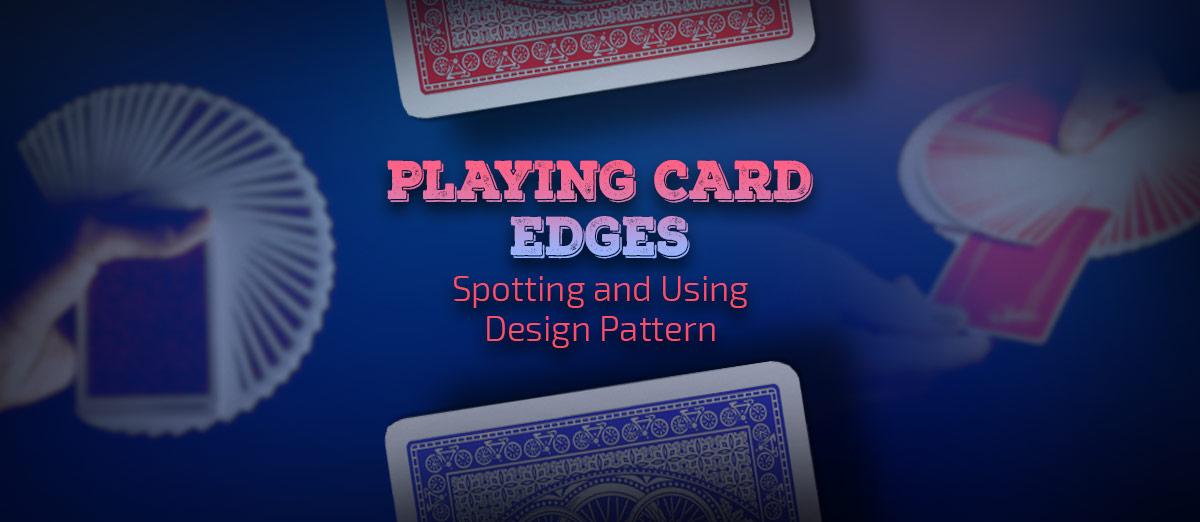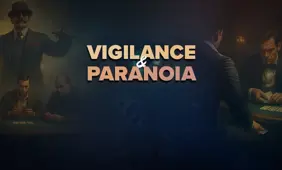Identifying Card Design Intricacies and Playing the Turn

As I've discussed elsewhere, using marked cards is not as easy as you might presume, and getting those cards into a desired game can be extremely difficult. When it comes to placing marked cards in a land based casino, cheaters have learned how to mark cards already in play or even mark cards at the factory, but what if almost every single deck of cards ever printed had a vulnerability that could help knowledgeable players (or cheaters) gain an unbeatable advantage against the house?
Do "Uncheatable" Cards Exist?
Many years ago, I was hired to represent a major playing card manufacturer at a large gaming conference, where I spoke to casino owners and other clients while demonstrating sleight of hand and other methods used to attack undefended games.
Sadly, one of the "defenses" being sold at that time was a type of back design that could supposedly prevent dealers from peeking or dealing seconds, false shuffling, or other acts of skill that might pervert the outcome of a game. This product was garbage, in my opinion, and I proved this by demonstrating all of these techniques with such a deck and had no trouble performing any sleight with any kind of playing card, regardless of its back design.
During that weekend, a client of this company who ran a casino somewhere in the midwest of America handed me one of these decks - the back design adapted to include his casino's logo - and told me they suspected foul play. The cards had come right off a live game and had not been shuffled or played with by anyone until I was asked to have a look.
After about thirty seconds of examining these cards, I asked the casino operator to shuffle them before I dealt the whole deck face down into two piles. Turning these over, the client was stunned to find all the high cards in one pile and all the medium to low cards in the other!
Of course, I am also a magician, and there are many ways to accomplish a feat like this, but thanks to a dishonest dealer somewhere, my work was already done once I saw the condition of those cards: They had been arranged thanks to how they were printed and cut by the manufacturer.
Let's start with the printing: these supposedly "uncheatable" cards had a white border to stop second dealing. Dealing seconds is definitely easier and more effective with a design that goes all the way to the edge of the card; the illusion is better and allows for less movement from both hands, but this sleight can be adapted to kill any "tell" created by a white border so dealing seconds would be just as likely if the crooked dealer understood how to hide the move.
What was more interesting - and infuriating - was that these supposedly cheat-proof cards had been miscut so that the white border was not an equal width all the way around the card. Instead, it had been cut at the factory so that one border was noticeably thicker than the others, and when I examined the used deck, I immediately noticed that some cards were turned one way and some were turned the other.
Most interestingly, the high cards were turned the opposite way from the others.
A dealer and his or her confederates had been "playing the turn" using this obvious one-way back design to distinguish between high and low cards. How long they had been playing this advantage is anyone's guess since casino management had dismissed the cards because they were "uncheatable" until this casino owner was smart enough to bring a deck to that gaming event.
Playing the Turn and How to Read Card Back Designs
This is a marked card play that has been around since cards were invented, and no matter what kind of cards you're using, there will be an inherent flaw that can be identified to allow "the turn" to be employed if that flaw is visible during play.
In other words: every deck of cards ever printed has been marked.
That's not to say it's easy to spot or practical to use, but whether looking for variance in the design itself or in how the design is positioned on the card, there will always be something that identifies one direction or another.
Take the ubiquitous "Bee" design, which is a repeating pattern of tiny diamonds that cover the entire back of a playing card. Most people would assume this cannot be a one-way back since the pattern is uniform but notice how those diamonds meet the edge of the cards, and you'll always find that one edge is different from the other in terms of how the diamonds are dissected on that edge. Sometimes the diamonds are cut, so two-thirds remain on that edge, but if you look to the opposite edge, only one-third remains.
If the diamonds are cut identically on the long edges, look to the short edges for a disparity, and you will never be disappointed. The placement of a logo on that "Bee" diamond-back pattern creates further, multiple points where the pattern meets the logo, and this is often much easier to spot than from the edge.
This design (and many like it) is used throughout the casino industry, but what if the cards are in a shoe and the shoe has a brush (a layer of interlacing bristles that cover the back of the next card but allows the dealers' fingers to push through and take that card)?
This is where that edge of the card becomes important because with all shoes, one long edge always protrudes just enough to get a read, and if the cards have been "turned," that read is actually easier if you only see the tiniest hair-width of playing card against the plastic dealing shoe. It's like reading a binary type of bar code where it's either type "0" or type "1," giving the players an enormous advantage against the house.
Most shoes will not have a brush and be open at the front, so the u-shaped opening, from where cards are dealt, can also meet the pattern of a back design like a handy measuring tool!
And what if the back of the card is mostly blank, perhaps with just the casino logo printed on it?
As stated earlier, the cards can sometimes be cut in such a way that one logo might be nearer the edge than the other, and I've even seen designs where the logos at either end of the cards were different! But even ignoring logos, sharp-eyed players have been able to find differences in how blank cards are embossed at either edge since modern cards often have a textured finish.
Such a read may be feasible with the cards in hand and the eyesight of a hawk, but generally speaking, using the plastic finish is far from practical. An easier solution to any "tough read" is to scratch one edge of the decks being used before gradually turning the valuable cards over time.
The plastic cut card employed in most table games can do a fine job of that with enough added pressure, and if the game is hand-dealt, confederates (of a crooked dealer) can see the good news coming before a round is even dealt.
Playing the turn is not just about identifying vulnerable back designs; those cards also need to be turned, and that can be a long process depending on the number of decks in play, but the end result is a deck (or decks) that tells players whether cards are high or low or any other valuable indicator to make crooked players' decisions far too accurate for any casino's liking.
Test the Trick Yourself
If you have some cards lying around, do grab them and see if you can spot the one-directional "tell," then turn them all one way, except for the four aces, which should be turned the opposite way. Now shuffle face down and deal the cards one at a time, placing any turned cards aside as you deal. Those should be the four aces, and when you turn them face up, you'll understand why this tactic is such a powerful weapon in the cheaters' arsenal.
Next up, we'll discuss how this simple strategy made millions for one of the most famous players on Earth without cheating and what the repercussions of that strategy exposed about the casino industry and the laws that serve to protect it.





Review this Blog
Leave a Comment
User Comments
comments for Identifying Card Design Intricacies and Playing the Turn